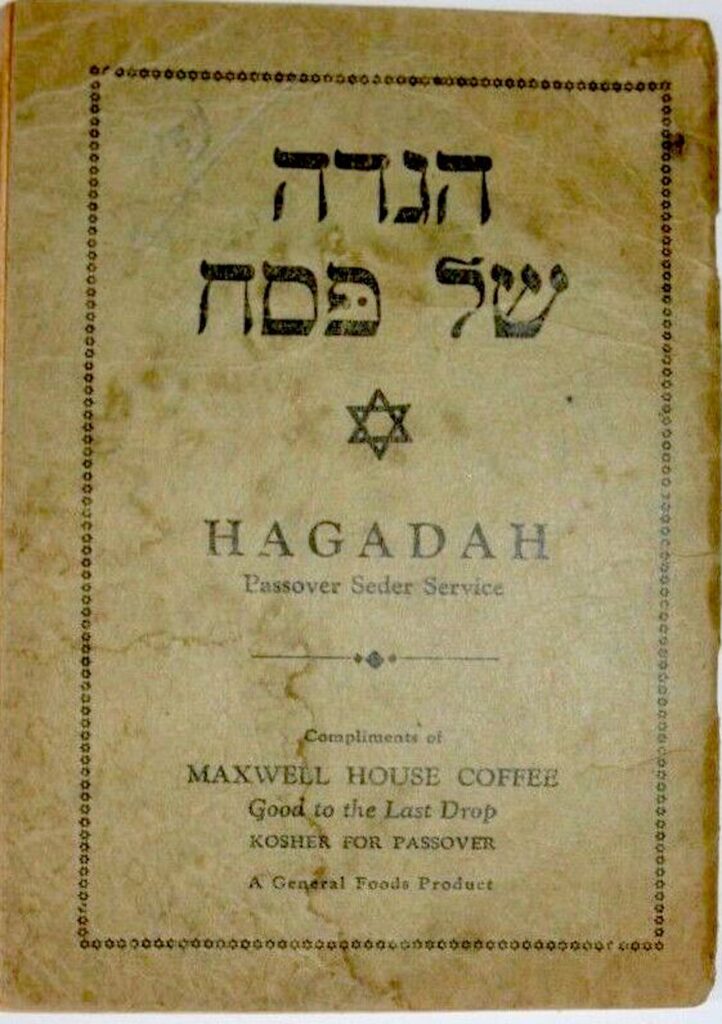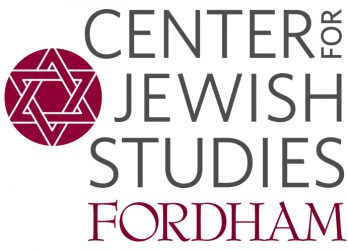by Joshua Eberle FCRH ’19 and GSE ’20
Fordham’s copy of the Haggadah Shel Pesah = Hagadah, Passover Seder Service / Compliments of Maxwell House Coffee, was published by Maxwell House Coffee and General Foods Corporation in 1941 in New York. The book was prepared by Joseph Jacobs Jewish Market a marketing firm that specialized in marketing to Jewish customers.[i] The English translation was done by an unknown translator.[ii]

The Maxwell House Haggadah began as part of a promotional plan by Maxwell House to sell their coffee to Jews as kosher for Passover.[iii] For years coffee beans were labeled as not kosher for Passover due to an old Ashkenazi tradition of categorizing coffee beans as legumes.[iv] Copies were given out at stores along with purchases of Maxwell House coffee products. The Maxwell House Haggadah has been published every year since 1932, except for two years during World War II when the United States was suffering from a paper shortage, most likely at the peak of America’s paper shortage around 1944.[v]
There have been very few changes to the Maxwell House Haggadah over the years in terms of content and format. The exceptions to this include the “Deluxe version” introduced in the 1960s, which contained an Ashkenazic transliteration for those who could not read Hebrew and a blue cover.[vi] Additional changes included the illustrations within the Haggadah being replaced by pictures of families observing Passover and a move away from the simple single colored covers in 2000,[vii] and an update to the English translation in 2011 making the Haggadah’s language more suitable to a modern audience and including the use of gender-neutral pronouns. The 2011 translation was by Henry Frisch, a high school English teacher from Teaneck, New Jersey.[viii]
The Maxwell House Haggadah is a small book, approximately seven inches long by five inches wide. It has around sixty pages read from right to left like many traditional Jewish texts.[ix] The pages are formatted so that the Hebrew translation is on the right side of each page and the English translation is on the left side. The font only varies in size on occasion within the text: in the captions below the printed pictures, which are a smaller bolded font, and in the form of smaller text which is placed throughout the Haggadah to provide specific instructions for parts of the Seder in the English section and references to biblical verses in the Hebrew section.[x] Towards the end of the 1941 copy of the Maxwell House Haggadah there are some specific Passover recitations in smaller English and Hebrew fonts.
When the Maxwell House Haggadah’s were introduced they were intended to be unobtrusive regarding the advertisement for Maxwell House brand coffee products. Because of this all copies of the Maxwell House Haggadah include an advertisement page only on the back inside cover of the text.[xi] The front inside cover of the Maxwell House Haggadah includes an abridged 5-year calendar of the Jewish Holidays as well as a description of the origin of the pictures printed within the text.
Fordham University’s copy contains 15 printed pictures, which the book states are reproductions of Medieval paintings and woodcuts. The pictures depict various Biblical scenes from the book of Exodus and beyond. The original Haggadah printed in 1932 had fewer pictures that were reproductions of pictures from the 1695 Amsterdam Haggadah.[xii]
The first few pages of the Haggadah provide a brief introduction to the Passover holiday and its foundations in the book of Exodus.[xiii] They also contain a “thank you” from Maxwell House Coffee and General Foods Corporation that stresses Maxwell House Coffee’s friendly relationship with the Jewish community, stating that the company takes, “great pleasure in extending best wishes for a happy and joyous holiday.”
The Maxwell House Haggadot are mass produced and are printed on cheaper quality paper. The 1941 copy of the Maxwell House Haggadah found in the Fordham Library Special Collections has pages that have turned yellow due to age and a dull greenish-blue cover that has faded over the years.
The size and quality of the Maxwell House Haggadah show that this book was intended for individual use. The Maxwell House Haggadah is bi-lingual in Hebrew and English aimed to fulfill the needs of a Jewish-American audience. The Haggadah also contains directions to follow during the Passover Seder in the text, including directions on when to say specific prayers, directions on when to perform certain actions, such as breaking the matzo, and cues for when to read parts of the Haggadah suggests that it could be used even by those who knew little about the ritual. These books were made to be free and accessible to average Jewish-American families and were produced as part of an advertisement campaign to increase the sale of coffee around Passover. In fact that the books were handed out in bulk along with purchase of Maxwell House Coffee products.[xiv]
During its long history over fifty million copies Maxwell House Haggadot have been distributed turning the Maxwell House Haggadah into something of a cultural icon in the Jewish-American community.[xv] It is the most widely used Haggadah in the world and is only distributed in the United States. It has been issued to U.S. soldiers in every campaign since 1932.[xvi] From 2009-2016 during the Obama Administration, a copy of the Maxwell House Haggadah was used for White House Passover Seders.[xvii]
The Maxwell House Haggadah has achieved great success because it was able to accomplish a major marketing goal of becoming a regular tradition for many Jewish-American families, many of whom make it a tradition to go out every year to pick up their new Haggadot.[xviii] It played a role in the Americanization of Jews.
Maxwell House Coffee and General Foods Corporation have published several books over the decades. There have not been any other books targeted at specific religious or ethnic groups published by Maxwell House Coffee. Many of the books that have been published by these companies are cookbooks and books about proper storage of and enjoyment of coffee. However, some of the books published by these companies are a bit more random in their nature and are more like the Haggadah because they were created as promotional materials for the companies or made in collaboration with other companies. Two such books are the Maxwell House Viewers Guide to the 1988 Olympics Winter Games (1988) and A Field Guide to the Great Outdoors: Western States (1983), published with Rand McNally and Company.
Books published by Maxwell House and General Foods follow a similar style to the Haggadot. They are printed in smaller sizes and contain a small number of pages. These books published by these companies were meant to be read and owned by individual consumers for personal use rather than published for larger audiences in more grandiose settings. These two examples were printed after the original publication of the Maxwell House Haggadah so one can assume that the format and publication of the Haggadot since 1932 had an influence on the methods of printing and publication used for books that were published later.
Joshua Eberle graduated from Fordham College at Rose Hill in 2019 with a BA in Political Science and Government and 2020 with MA in Adolescent Social Studies Education. He wrote this essay in the fall of 2018 in Professor Magda Teter‘s class HIST1851: Jews in the Modern World. The book “You Can Judge a Book by Its Cover: A Jewish History through Used Books” with this essay and those by other students can be downloaded here.

